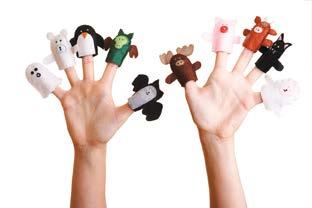
4 minute read
NATURE SPEAKS
STORYTELLING CONNECTS KIDS TO THE NATURAL WORLD
by Carrie Jackson
Advertisement
Children are natural storytellers with imaginations that shape their play and learning. In outdoor settings, everything from puddles to pine cones can engage children and draw them closer to the natural world, opening up a lifelong appreciation of natural environments. Connecting with nature also improves creativity, academic performance and attentiveness, while reducing stress and aggressive behavior, a body of research shows.
Organizations, like the Wilderness Awareness School, a Duvall, Washington-based nonprofit, work to help children and adults cultivate healthy relationships with nature, community and self. “We find that children who feel at home in the outdoors are often more resourceful, creative and allow for curiosity to naturally unfold,” says Leah Carlson, director of marketing and communications at Wilderness Awareness School. “Allowing them to play freely and explore in nature is a wonderful way to build resilience and resourcefulness. When children can be intrigued through a story, it also allows them to understand their own outdoor experiences. They become more


adept at finding new solutions to problems using the tools they have access to and creative thinking.”
Weaving storytelling into their programs helps children understand their outdoor experiences. “Regular time spent with experienced nature mentors, playing games, exploring unique plants and animals and getting excited about the possibilities of nature is how a connection begins. When children are outside, the characters of these stories are the plants, animals, rocks and landforms around them. The suburban tree that was always an obstacle on the sidewalk can be seen through new eyes as a dragon, monkey bars or a red alder,” Carlson explains.
Megan Zeni, a public school teacher in Steveston, British Columbia, says there is a global body of research that shows every measure of wellness is improved through time spent outside. She teaches solely outdoors, ensuring that her students have exposure to nature regardless of which neighborhood they live in. “In our modern world, higher-income families generally have better access to green spaces. Incorporating outdoor activities into the school day gives children equitable exposure to nature and outdoor learning,” she explains.
Zeni uses both non-fiction and fiction storytelling approaches to teaching. “To learn about water cycles, I’ll have kids jump in puddles, observe where the water goes and track where it is in the community. They’ll then relay a fact-based story based on their observations and experiences. For a lesson on squirrels, I’ll ask the students to imagine where their habitat is, who their family is and what they eat. We use loose parts, which are open-ended items, such as pine cones and sticks, to creatively illustrate the story.
“By using storytelling as a measure of knowledge, it is more equitable for students who don’t perform as well using traditional test and essay methods,” she says. Listening to a child’s story can also reveal misconceptions that can be clarified through further exploration and instruction.
Storytelling can take on many forms and be enhanced with the use of props. As the artistic director of Rootstock Puppet Co., based in Chicago, Mark Blashford performs puppet theater rooted in stories that promote mutual kindness and ecological awareness. “Puppets are remarkable storytelling agents because, not only can they play characters and support narrative through movement, they can also tell a story from the very material they inhabit,” he says. “Puppets invite kids to exercise empathy by compelling them to accept and invest in the thoughts, feelings and life of another entity.”

natalia/AdobeStock.com
By making puppets out of wood and using them to weave environmental awareness into his shows, Blashford helps to put the natural world in perspective. “My show TIMBER! is about an entire forest and a single tree which is home to a family of spotted owls. I want children to see the role of both the forest and the tree in the lives of an owl family. When they fall in love with little wooden puppet owls, they are able to convert the giant concept of deforestation into a manageable scale,” he says.
He encourages parents to regularly engage their children with their natural habitat. “Go to your local forest or park, find a tree, name it and check on it as often as you can. Prompt children to ask questions about who they think lives in that tree, why the branches stretch out how they do and what happens at night. As children learn to see the outdoor world as part of their own characters and setting, the stories will develop naturally,” he advises. Connect with writer Carrie Jackson at CarrieJacksonWrites.com.
LEARN MORE
Rootstock Puppet Co.: rootstockpuppet.com
Wilderness Awareness School: wildernessawareness.org
Megan Zeni: meganzeni.com
Are You Ready for a Career Change?
Earn a Master’s Degree in Acupuncture & Chinese Medicine
Classics Integrated with Traditional Chinese Medicine®
Dragon Rises College of Oriental Medicine
Gainesville • Florida www.dragonrises.edu
for more information: info@dragonrises.edu (800) 606-6685
License No. 2425. The Florida Commision for Independant Education. Accreditation www.ACAHM.org
Make your community a little GREENER … Support our advertisers
For every $100 spent in locally owned business, $68 returns to the community
source: the350project.net







